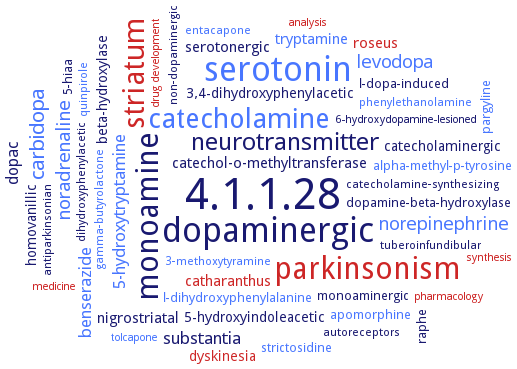4.1.1.28: aromatic-L-amino-acid decarboxylase
This is an abbreviated version!
For detailed information about aromatic-L-amino-acid decarboxylase, go to the full flat file.

Word Map on EC 4.1.1.28 
-
4.1.1.28
-
dopaminergic
-
serotonin
-
parkinsonism
-
monoamine
-
striatum
-
catecholamine
-
neurotransmitter
-
carbidopa
-
noradrenaline
-
levodopa
-
norepinephrine
-
benserazide
-
5-hydroxytryptamine
-
substantia
-
dopac
-
serotonergic
-
tryptamine
-
nigrostriatal
-
catharanthus
-
catechol-o-methyltransferase
-
roseus
-
beta-hydroxylase
-
5-hydroxyindoleacetic
-
homovanillic
-
3,4-dihydroxyphenylacetic
-
catecholaminergic
-
dyskinesia
-
dopamine-beta-hydroxylase
-
alpha-methyl-p-tyrosine
-
5-hiaa
-
pargyline
-
strictosidine
-
monoaminergic
-
raphe
-
l-dopa-induced
-
l-dihydroxyphenylalanine
-
apomorphine
-
antiparkinsonian
-
gamma-butyrolactone
-
tuberoinfundibular
-
autoreceptors
-
3-methoxytyramine
-
quinpirole
-
entacapone
-
catecholamine-synthesizing
-
dihydroxyphenylacetic
-
non-dopaminergic
-
phenylethanolamine
-
pharmacology
-
analysis
-
6-hydroxydopamine-lesioned
-
medicine
-
drug development
-
synthesis
-
tolcapone
- 4.1.1.28
-
dopaminergic
- serotonin
- parkinsonism
-
monoamine
- striatum
- catecholamine
-
neurotransmitter
- carbidopa
- noradrenaline
- levodopa
- norepinephrine
- benserazide
- 5-hydroxytryptamine
-
substantia
-
dopac
-
serotonergic
- tryptamine
-
nigrostriatal
- catharanthus
- catechol-o-methyltransferase
- roseus
- beta-hydroxylase
-
5-hydroxyindoleacetic
-
homovanillic
-
3,4-dihydroxyphenylacetic
-
catecholaminergic
- dyskinesia
- dopamine-beta-hydroxylase
- alpha-methyl-p-tyrosine
-
5-hiaa
- pargyline
- strictosidine
-
monoaminergic
-
raphe
-
l-dopa-induced
- l-dihydroxyphenylalanine
- apomorphine
-
antiparkinsonian
- gamma-butyrolactone
-
tuberoinfundibular
-
autoreceptors
- 3-methoxytyramine
- quinpirole
- entacapone
-
catecholamine-synthesizing
-
dihydroxyphenylacetic
-
non-dopaminergic
- phenylethanolamine
- pharmacology
- analysis
-
6-hydroxydopamine-lesioned
- medicine
- drug development
- synthesis
- tolcapone
Reaction
Synonyms
3,4-dihydroxyphenylalanine carboxylase, 3,4-Dihydroxyphenylalanine decarboxylase, 5-Hydroxy-L-tryptophan decarboxylase, 5-Hydroxytryptophan decarboxylase, 5-hydroxytryptophan hydroxylase, 5HTP decarboxylase, AAAC, AAAD, AACD, AADC, AADC1A, AADC1B, AADC393, AADC438, AADC486, Alt-DDC, aromatic acid acid decarboxylase, Aromatic amino acid decarboxylase, aromatic amino acid decarboxylase 1A, aromatic amino acid decarboxylase 1B, Aromatic L-amino acid decarboxylase, aromatic L-aminoacid decarboxylase, aromatic-L-amino-acid decarboxylase, CrTDC, DDC, Decarboxylase, aromatic amino acid, Di-ADC, Dihydroxyphenylalanine-5-hydroxytryptophan decarboxylase, DOPA DC, dopa decarboxilase, DOPA decarboxylase, DOPA-5-hydroxytryptophan decarboxylase, DOPA/5HTP decarboxylase, dopamine decarboxylase, EC 4.1.1.26, EC 4.1.1.27, HsDDC, Hydroxytryptophan decarboxylase, L-3,4-Dihydroxyphenylalanine decarboxylase, L-5-Hydroxytryptophan decarboxylase, L-amino acid decarboxylase, L-amino-acid decarboxylase, L-Aromatic amino acid decarboxylase, L-aromatic aminoacid decarboxylase, L-DOPA decarboxylase, L-Tryptophan decarboxylase, neural-type DDC, non-neural DDC, PP_2552, TDC, TDC2, Tenebrio Dopa decarboxylase, Trp decarboxylase, Tryptophan decarboxylase, tryptophan decarboxylase-1, tryptophan decarboxylase-2, TYDC, Tydc9, Tyrosine/Dopa decarboxylase


 results (
results ( results (
results ( top
top






